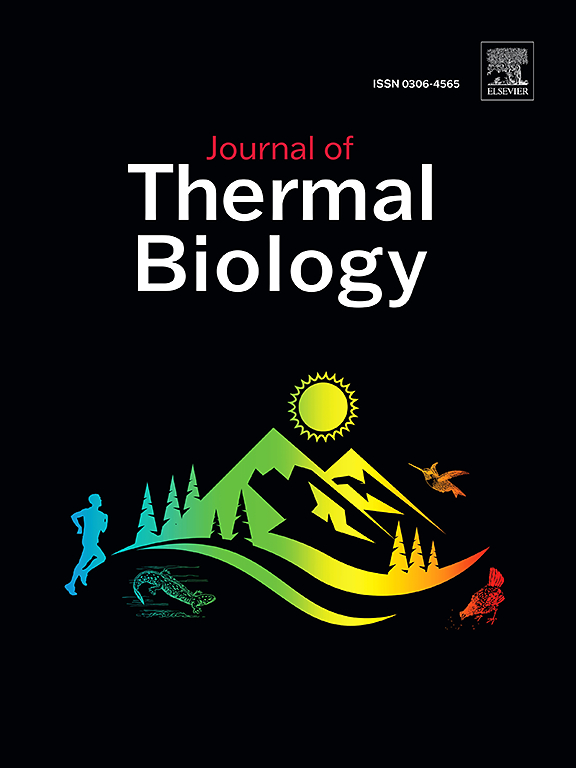不同气候条件下Polistes生命阶段的临界热最大值,并对方法进行了关键评估
IF 2.9
2区 生物学
Q2 BIOLOGY
引用次数: 0
摘要
环境温度对于外温动物来说是一个至关重要的非生物因素。它对昆虫的发育、生命和数量以及在新栖息地定居的成功与否都有很大影响。在具有开放式巢穴的群居昆虫 Polistes sp.中,幼虫和蛹在应对高环境温度时影响自身体温的选择有限。它们只能依靠成虫采取措施将体温保持在可承受的水平。我们测定了三种纸蜂(Polistes dominula、P. gallicus、P. biglumis)在不同气候条件下(温带、地中海、高山)三个生命阶段(幼虫、蛹、成虫)的野外种群热上限(CTmax)。由于各生命阶段的形态和生理特点不同,它们对温度升高和热应激在呼吸和身体运动方面的反应也不尽相同。因此,我们必须开发一种基于长期呼吸模式的适应性评估方法。最显著的结果是,所有种群和生命阶段的 CTmax 都相似,幼虫和蛹的 CTmax 为 47.6 至 48.8 °C,成虫的 CTmax 为 47.1 至 47.9 °C。P.dominula与P.gallicus和P.biglumis不同;后者没有显著差异(所有阶段)。对单个组别(种群、生命阶段)的测试表明,其中一个参数或其他参数(种群、生命阶段、质量)存在差异。总体而言,种群(因此气候也是一个相关因素)和生命阶段对 CTmax.s 有显著影响,但对质量没有显著影响。本文章由计算机程序翻译,如有差异,请以英文原文为准。

Critical thermal maxima of Polistes life stages from different climates, with a critical evaluation of methods
Ambient temperature is a crucial abiotic factor for ectotherms. It strongly influences development, life and abundance, as well as success in colonizing new habitats. In the eusocial paper wasps Polistes sp., colony-forming insects with open nests, the larvae and pupae have limited options to influence their own body temperature in response to high environmental temperatures. They are dependent on measures taken by the adults to keep it at tolerable levels. We determined the upper thermal limits (CTmax) in field populations of three paper wasp species (Polistes dominula, P. gallicus, P. biglumis) from different climates (temperate, Mediterranean, alpine) for three life stages (larvae, pupae, adults). Due to morphological and physiological characteristics of the individual life stages, they did not show the same reactions to temperature rise and heat stress in terms of respiration and body movement. CTmax evaluation by established methods (mortal fall, short-term respiration patterns) was not possible, so we had to develop an adapted evaluation type based on long term respiration patterns. The most striking result was that the CTmax was similar in all populations and life stages, ranging from 47.6 to 48.8 °C in larvae and pupae, and from 47.1 to 47.9 °C in adults. P. dominula differed from P. gallicus and P. biglumis; the latter did not differ significantly (all stages). Tests in individual groups (populations, life stages) showed differences in one parameter or the other (population, life stage, mass). Overall, population (and thus climate as a related factor) and life stage, but not mass, had a significant effect on CTmax.s
求助全文
通过发布文献求助,成功后即可免费获取论文全文。
去求助
来源期刊

Journal of thermal biology
生物-动物学
CiteScore
5.30
自引率
7.40%
发文量
196
审稿时长
14.5 weeks
期刊介绍:
The Journal of Thermal Biology publishes articles that advance our knowledge on the ways and mechanisms through which temperature affects man and animals. This includes studies of their responses to these effects and on the ecological consequences. Directly relevant to this theme are:
• The mechanisms of thermal limitation, heat and cold injury, and the resistance of organisms to extremes of temperature
• The mechanisms involved in acclimation, acclimatization and evolutionary adaptation to temperature
• Mechanisms underlying the patterns of hibernation, torpor, dormancy, aestivation and diapause
• Effects of temperature on reproduction and development, growth, ageing and life-span
• Studies on modelling heat transfer between organisms and their environment
• The contributions of temperature to effects of climate change on animal species and man
• Studies of conservation biology and physiology related to temperature
• Behavioural and physiological regulation of body temperature including its pathophysiology and fever
• Medical applications of hypo- and hyperthermia
Article types:
• Original articles
• Review articles
 求助内容:
求助内容: 应助结果提醒方式:
应助结果提醒方式:


